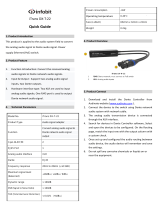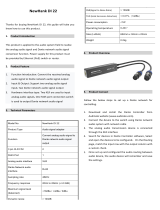
KH 120 II AES67 / KH 150 AES67 | 7
Positioning the loudspeakers
XCarry out the following steps very accurately, since the more accurate the physical arrange-
ment of the loudspeakers in the room, the more accurate the reproduction will be at the
listening position.
XObserve the recommended distances between the loudspeakers and your listening position:
• Recommended listening distance for KH 120 II AES67: 1.0m – 2.0m
• Min./max. listening distance for KH 120 II AES67: 0.75m – 4.0m
• Recommended listening distance for KH 150 AES67: 1.0 m – 2.5m
• Min./max. listening distance for KH 150 AES67: 0.75m – 6.0m
XAvoid positioning the loudspeaker at a distance (dwall) of 0.8 to 1.75m from the wall behind
the loudspeaker. When positioning bass-managed loudspeakers, avoid a distance (dwall) of
0.8 to 1 m from a solid wall behind the loudspeaker. Similarly, avoid these distances from
solid side walls or a solid ceiling. Respecting these positioning limitations reduces the
chances of dips in the low frequency response (comb filtering) caused by strong reflections.
XPrint out the “Installation angles” diagram that can be found at the end of this operating
manual.
XPlace the diagram at the listening position or the center of the listening area.
XUsing a tape measure, place the loudspeakers at the same distance from the center of the
diagram “Installation angles”. To ensure good imaging, do this at an accuracy of at least
1cm.
XIf the loudspeakers cannot be placed at the same distance from the listening position, com-
pensate for distance dierences > 1cm by delaying closer loudspeakers by 30 s/cm. The
MA 1 – Automatic Monitor Alignment software automatically compensates for dierent dis-
tances between the loudspeakers and the listening position.
XArrange the loudspeakers as follows:
• 2.0 systems (stereo): ± 30°, plus optional subwoofer(s)
• 5.1 systems:
ITU-R BS.775-1: 0°, ±30°, ±110° (±10°), plus optional subwoofer(s)
(center, front left/right, surround left/right)
ANSI/SMPTE 202M: 0°, ± 22.5°, one surround array left and right, plus optional
subwoofer(s)
• 7.1 systems: 0°, ± 30°, ± 90°, ± 150°, plus optional subwoofer(s)
(center, front left/right, side left/right, back left/right)
• 3D systems See the recommendations from Dolby, DTS, Auro3D and
ITU-R BS.2051-0 for loudspeaker positioning.
The acoustical axis of the loudspeaker is between the bass and tweeter drivers.
XAlways point the acoustical axis, in the horizontal and vertical planes, towards the listening
position.
The acoustical axis is a line perpendicular to the loudspeaker’s front panel along which
the microphone was placed to tune the loudspeaker’s crossover when the monitor was
designed. Pointing the acoustical axis, in the horizontal and vertical planes, toward
the listening position or center of the monitoring area will give the best measured and
perceived transient response quality.
XPosition the loudspeaker so that there is a direct line of sight from the listening position to
the bass and tweeter drivers.
XMake sure that the ports are not blocked or partially covered.
XKeep sharp edges away from the port outlets, as they can cause air noise.
Distances
wall
Angular positioning
of the loudspeakers
KH 120 II:
x = 91 mm
y = 166 mm
KH 150:
x = 112,5 mm
y = 197 mm
EN





















